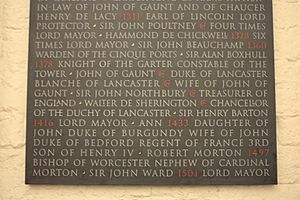John de Pulteney facts for kids
Quick facts for kids
Sir John de Pulteney
|
|
|---|---|
| Died | 8 June 1349 |
| Spouse(s) | Margaret de Bereford |
| Issue | William de Pulteney |
| Father | Adam de Pulteney |
| Mother | Matilda |
Sir John de Pulteney (sometimes spelled Poultney) was an important English businessman and landowner. He lived a long time ago, in the 1300s. Sir John was so important that he served as the Mayor of London four different times! He passed away on June 8, 1349.
Contents
Sir John's Family Life
Sir John de Pulteney's parents were named Adam and Matilda.
Marriage and Children
Sir John married a woman named Margaret. She was the daughter of John de Bereford, who was also an important person in London. They got married by December 1330.
Sir John and Margaret had one child together:
- William de Pulteney (who lived from 1340 to 1366 or 1367)
After Sir John passed away, his wife Margaret married another man, Sir Nicholas de Loveyne.
Where Sir John Was Buried
Sir John was buried in a very famous church called Old St Paul's Cathedral in London. Sadly, the church and his grave were destroyed in the Great Fire of London in 1666. Today, there's a special memorial in the church's crypt. It lists his name among other important people whose graves were lost. You can see a picture of it above.
Sir John's Amazing Career
Sir John was a proud citizen of London. He was also a member of the Drapers’ Company, which was a group for people who traded cloth.
His Business Activities
Sir John was very good at business. He often lent money to others. For example, in 1325, he lent money to a man named Robert Burdet. He even lent a large sum of money to the King of England! This shows how wealthy and trusted he was.
His Role as Mayor
Sir John was chosen to be the Mayor of London four times. He served in 1331, 1332, 1334, and 1336. Being mayor was a very big job. He also held other important positions, like being the Escheator of the City of London. This role involved managing property that went back to the King. He also helped with important discussions with other countries, like Flanders.
Buildings Sir John Built
Sir John used his wealth to build some amazing places. Many of these projects happened around 1341. He even got permission to build strong, castle-like walls around his homes.
Penshurst Place
Penshurst Place was built around 1341. It's a very old and beautiful house. Even though parts of it were added later, the huge main hall with its fancy wooden roof was built during Sir John's time.
Coldharbour House
Sir John built a large house in London called Coldharbour House. It was also known as Pulteney House. This mansion had a great view of the River Thames. After Sir John died, a famous person called the Black Prince lived there for a while.
St Laurence Pountney College
Sir John added a special chapel to the St Laurence Pountney church in London. This chapel was built by 1332. It was a place for prayers and services.
Carmelites Church, Coventry
Around 1342, Sir John paid for the building of a monastery in Coventry. It was for a group of monks called the Carmelites.
Cheveley Castle
Sir John was allowed to build defenses at his manor in Cheveley, Cambridgeshire. Not much of this building is left today. So, it's hard to know exactly what he built there.
Sir John's Death and Properties
Sir John passed away on June 8, 1349. This was during the time of the Black Death, a terrible disease that spread across Europe. It's possible he died from it, but we don't have proof.
When he died, Sir John owned many properties. This shows how successful he was. Here are some of the places he owned:
- In Cambridgeshire: Land in Woodditton, Cheveley, and Swaffham Prior.
- In Hertfordshire: A manor in Shenley.
- In Kent: Manors in Ospringe, Penshurst, Yenesfield, Plumstead, and Southalle.
- In Leicestershire: Manors in Pulteney and Misterton. Land in Dadlington.
- In London: Many properties and rents.
- In Middlesex: A manor in Poplar and mills in East Smithfield.
- In Suffolk: A manor in Withersfield.
- In Warwickshire: Property in Napton and Shotteswell.
His Will
Sir John made his will on November 14, 1348. In his will, he left money to support prayers for his soul and for his family members. These prayers were to be paid for by his properties in London.
He left his main house to his wife, Margaret. She could live there until she remarried. After that, it would go to his son, William. Sir John also left special gifts to the people who would help carry out his will. These gifts included a beautiful ring with a large ruby and another ring with two diamonds. He also left silver cups and a matching spoon and salt shaker. These gifts show how rich he was!


